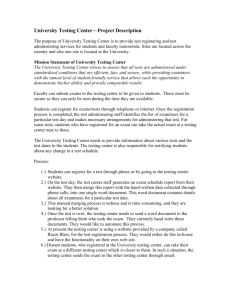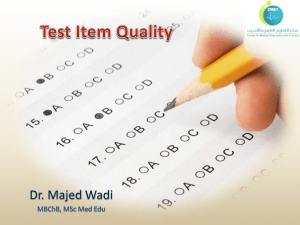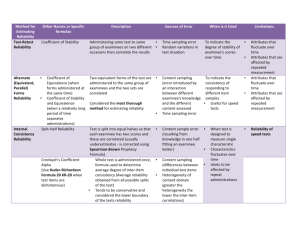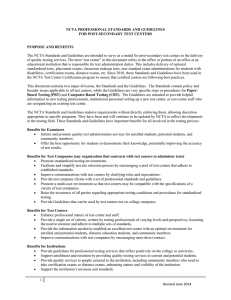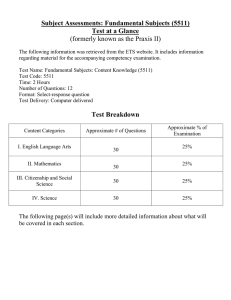NCTA PROFESSIONAL STANDARDS AND GUIDELINES FOR POST-SECONDARY TEST CENTERS BACKGROUND AND PURPOSE
advertisement
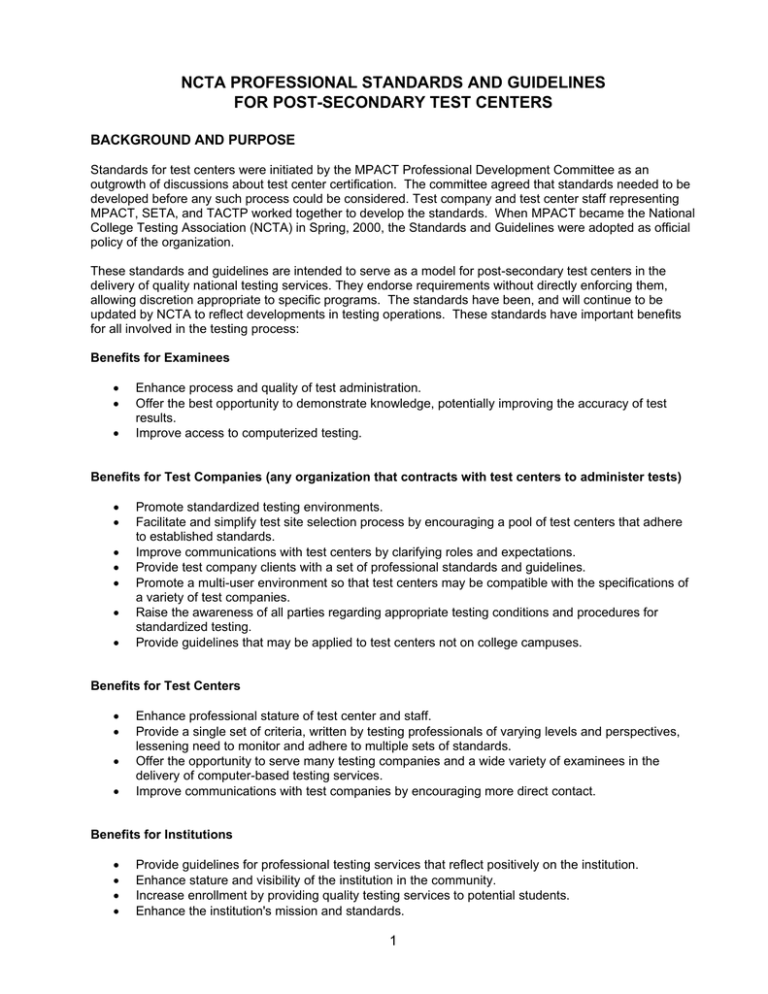
NCTA PROFESSIONAL STANDARDS AND GUIDELINES FOR POST-SECONDARY TEST CENTERS BACKGROUND AND PURPOSE Standards for test centers were initiated by the MPACT Professional Development Committee as an outgrowth of discussions about test center certification. The committee agreed that standards needed to be developed before any such process could be considered. Test company and test center staff representing MPACT, SETA, and TACTP worked together to develop the standards. When MPACT became the National College Testing Association (NCTA) in Spring, 2000, the Standards and Guidelines were adopted as official policy of the organization. These standards and guidelines are intended to serve as a model for post-secondary test centers in the delivery of quality national testing services. They endorse requirements without directly enforcing them, allowing discretion appropriate to specific programs. The standards have been, and will continue to be updated by NCTA to reflect developments in testing operations. These standards have important benefits for all involved in the testing process: Benefits for Examinees • • • Enhance process and quality of test administration. Offer the best opportunity to demonstrate knowledge, potentially improving the accuracy of test results. Improve access to computerized testing. Benefits for Test Companies (any organization that contracts with test centers to administer tests) • • • • • • • Promote standardized testing environments. Facilitate and simplify test site selection process by encouraging a pool of test centers that adhere to established standards. Improve communications with test centers by clarifying roles and expectations. Provide test company clients with a set of professional standards and guidelines. Promote a multi-user environment so that test centers may be compatible with the specifications of a variety of test companies. Raise the awareness of all parties regarding appropriate testing conditions and procedures for standardized testing. Provide guidelines that may be applied to test centers not on college campuses. Benefits for Test Centers • • • • Enhance professional stature of test center and staff. Provide a single set of criteria, written by testing professionals of varying levels and perspectives, lessening need to monitor and adhere to multiple sets of standards. Offer the opportunity to serve many testing companies and a wide variety of examinees in the delivery of computer-based testing services. Improve communications with test companies by encouraging more direct contact. Benefits for Institutions • • • • Provide guidelines for professional testing services that reflect positively on the institution. Enhance stature and visibility of the institution in the community. Increase enrollment by providing quality testing services to potential students. Enhance the institution's mission and standards. 1 Benefits for NCTA • • • • Offer an opportunity to develop a formal training program for members. Provide interaction with non-member test centers and staff, increasing organizational resources. Show that enhancement of professionalism in the field of testing is a primary purpose of NCTA. Increase value of belonging to an association with professional standards, potentially increasing membership. I STANDARDS FOR TEST CENTERS The standards in this document are organized into five sections: Policy, Contractual Agreements, Staffing, Institutional Representation and Coordination, and Physical Environment. Certain items pertain to computer-based testing only. If CBT is not specified, items cover both paper-based and computerized testing: A. POLICY: Test Centers must adhere to general policies which promote high quality operations, ethical practices as outlined in the Code for Fair Testing Practices in Education, professional mandates, and policies consistent with their institutions and NCTA. They must: 1. Develop and implement a mission statement consistent with the policies and standards set forth in this document. 2. Operate with adequate financial resources to support the mission of the testing program. 3. Maintain adequate physical facilities and location suitable to the requirements of the testing program. 4. Operate in a diligent manner to promote honesty, integrity, and fairness in all testing procedures. 5. Operate under the guidelines of equal opportunity, affirmative action, and the Americans with Disabilities Act (ADA), and other local, state, and federal regulations. 6. Protect the integrity of the test. 7. Protect the confidentiality and rights of privacy of examinees and staff. 8. Adhere to program requirements of testing companies in the administration of specific tests. 9. Adhere to requirements and policies of their institutions in the administration of classroom exams and other assessments. 10. Treat examinees in a fair, courteous, professional, and nondiscriminatory manner. 11. Address examinee concerns with empathy while maintaining the integrity of the administration. 12. Make referrals to other campus offices and testing resources, as needed, to provide students and clients with the most appropriate services of the institution and community. 13. Develop and implement appropriate guidelines for test center operations and staff training. 14. Evaluate the testing program in an on-going, systematic, and comprehensive manner. 2 B. CONTRACTUAL AGREEMENTS: Testing companies will send contracts to test centers to establish agreements for test delivery services. Specifics must be disclosed to test centers in advance to allow for any exceptions or special agreements to be negotiated. Contracts may be signed by the test center manager or another designee of the institution. Honorarium payments, reservations systems, and other aspects of business between the test center and test company will be covered by individual contract for computerized testing. For paper-based testing, some items will be covered in program manuals. 1. Payment for the delivery of testing services may be to the test center/institution, to individuals, or to both, as agreed to by the test center and test company. 2. Billing units, i.e., per testing hour, per test, per test session, are determined by agreement between the test center and the test company. 3. A mandatory token payment system will be in place, the specifics to be agreed upon in advance by test center and test company: a. For paper-based testing, all staff hired for testing will be paid a token honorarium if no examinees appear for testing. b. For computer-based testing, centers will be paid full honorarium for all no-show appointments and for late cancellations, i.e., those made past the cancellation deadline. C. 4. For computer-based testing, reservations may be handled locally or by a central reservation system, as specified by contract. 5. The testing company will cover any potential liability issues that arise from the implementation of their procedures and regulations, assuming test center staff carry out these procedures according to program requirements. STAFFING: A number of people may be involved in the setup and administration of tests. These may include regular staff of the institution and/or staff hired only for particular testing situations. In all cases, regardless of how specific tasks are divided, one person must be accountable. 1. The Testing Operations Manager is the primary institutional contact with the testing company and is ultimately responsible for the appropriate administration of testing programs. S/he coordinates all test administrations and may serve as test administrator or may hire others for test day administration. The Testing Operations Manager: a. Is an employee of the institution. b. Serves as administrator of record with test companies. c. Actively manages the overall testing program and procedures, though not necessarily acting as on-site supervisor. d. Is knowledgeable about test policies and processes. e. Is informed about all incidents occurring during testing, e.g. irregularities, facilities problems, examinee or staff concerns. f. Maintains direct contact with test company personnel. g. Fulfills test company requirements for each program. h. Maintains adequate staff to cover testing program demands. i. Has ultimate responsibility for the test administration, including adherence to all standards in this document. j. Participates in professional development activities to stay current with trends in testing. k. Conducts training for testing personnel, both part-time and full-time, to include all aspects of test administration, including management of emergency situations such as fire or illness. l. Evaluates the program and all testing staff at predetermined, regular intervals. 3 2. The Testing Operations Manager is responsible for appropriate contact and coordination with faculty and departments at the institution that use test center services, although daily contact with institutional personnel may be performed by other test center staff. The Testing Operations Manager: a. Is an employee of the institution. b. Actively manages the overall testing program and procedures, though others in the test center may have more regular contact with institutional faculty and department personnel. c. Is knowledgeable about test policies and processes. d. Is informed about all incidents occurring during testing, e.g. irregularities, facilities problems, examinee or staff concerns. e. Fulfills requirements for departmental or institutional testing, or informs faculty or department of limitations of service. f. Maintains adequate staff to cover testing demands. g. Has ultimate responsibility for the test administration, including adherence to all standards in this document. h. Conducts training for testing personnel, both part-time and full-time, to include all aspects of test administration, including management of emergency situations such as fire or illness. i. Evaluates the program and all testing staff at predetermined, regular intervals. 3. Test day administrators, room supervisors, and proctors may be regular staff of the institution, student employees, or on-call workers hired just for testing. Testing Operations Managers must avoid the reality or perception of conflicts of interest in the selection of staff. Particular attention must be paid to test company or institutional requirements for specific programs with regard to teaching in the content area of the test, test preparation activities, or inappropriate staff exposure to the test material. Efforts should also be made to hire staff reflective of the ethnicity and gender of the population being tested. It is imperative that test day staff: a. Attend general proctor or supervisor training. b. Proctor tests before becoming a room supervisor for national exams. c. Understand the concepts of institutional or standardized testing, the importance of test security, and the implications of testing irregularities. d. Read the manual for national exams prior to the test date, thoroughly reviewing specific program policies and procedures. For institutional testing programs, staff must be thoroughly informed about testing procedures. e. Be reliable, punctual, detail-oriented, and able to deal effectively with people in difficult situations. f. Undergo performance evaluation at regular intervals. 4. Office staff, secretaries, and student personnel of the testing center often assist with various aspects of the test administration process. It is essential that these staff members: a. b. c. d. Understand the requirement for security of test materials and examinee information. Assist Manager with assigned responsibilities. Review test procedures related to their assigned duties. Undergo performance evaluation at regular intervals. 4 D. INSTITUTIONAL REPRESENTATION AND COORDINATION: The Test Operations Manager is responsible for advocating for the needs of the testing program with the administration of the institution. In addition, test center personnel are encouraged to make formal and informal connections across the campus for the purposes of informing others about testing services, to promote appropriate interaction between the test center and other institutional departments, and to assure effective facilitation of test administration. Institutional representation and coordination are intended to establish and maintain administrative support for testing functions and increase the level of visibility on campus and in the community. 1. The testing program will be represented at various levels within the organizational structure. As needs are identified, the program will make these needs, and the resources required, known to the appropriate personnel and offices in the institution. 2. To develop an effective communication network with departments that provide campus services, test centers must: a. Develop working relationships with campus resource personnel who authorize access to appropriate facilities. b. Coordinate with other significant institutional departments to assure all relevant services are provided. Call and/or meet with department contacts, e.g., Facilities Management, Public Safety, Energy Management, Buildings and Grounds, Plant Operations, Mail Center, to assure that buildings and rooms are unlocked, temperature systems are in place, special equipment is available and functioning, setup is appropriate, etc. c. Communicate assessment goals and objectives across the campus and in the community. 3. To implement appropriate public relations activities on behalf of the test center, it is important to: a. Heighten awareness of the test center and its services by providing accurate, up-to-date information via flyers, brochures, newsletters, web pages, correspondence, etc. b. Encourage appropriate use of testing services. 4. E. To achieve efficient, reliable, and timely test administration of current or prospective students of the institution (placement exams, institutional national exams, credit by exam, and classroom testing), test centers must: a. develop effective working relationships with faculty and institutional departments. b. collaborate and communicate with faculty and academic departments about policies and procedures for the administration of classroom exams and other assessments. c. maintain appropriate records (e.g. test tracking logs, program statistics, and exam scores). PHYSICAL ENVIRONMENT: The location, space, and layout of the testing center are vital to the accomplishment of its mission. In addition, the conditions under which tests are handled, stored, and administered are extremely important. The standardization of these conditions is essential to the integrity of every test administration. 1. To assure security of materials, the area where test materials are stored must: a. Be locked with no insecure points of access, e.g., windows, transoms, false ceilings, etc. b. Have access limited to key testing personnel. 2. At the test site, the Testing Operations Manager and/or staff must: a. Maintain a distraction-free testing environment; anticipate outside factors that may divert the attention of examinees, and take action to avoid these. b. Consider room temperature; attempt to correct as needed. 5 c. Assure adequate lighting (using established guidelines). d. Provide adequate test room(s)/space for given volume. e. Provide seating and writing surfaces appropriate for test volume, test materials, candidate characteristics, ADA, and other special requirements. f. Seat examinees according to company specification, to limit their view of others’ work. g. Check facility to assure readiness for testing. h. Have backup plans in case of emergency or problem, if possible. Contact company about shift to any backup plan. 3. Access to the test site requires that: a. Adequate parking is available. b. ADA requirements are met. 4. Special Accommodations: a. Test centers will provide testing to persons with disabilities, with accommodations approved by test companies, if possible. b. If the accommodation requires only a modification that will not disturb others, such as a pillow or an oversized table, the person may be tested in a room with other examinees. c. If the accommodation requires extra time and/or any accommodation(s) that may distract other examinees, such as reading aloud, a separate room will be provided, if available. d. For computerized testing: If a separate room is required but not available, the test center will attempt to schedule the test outside of regular testing hours, so the entire center does not need to be shut down. If this is not possible, then the room will be used only for the accommodated testing, and the test company will pay for a minimum number of test stations, as specified by contract between the test center and test company. 5. Computer-Based Testing: Equipment and Space a. Hardware and software requirements for computerized testing will be set at a basic level that allows usage by multiple testing company programs. Test companies wanting to utilize CBT centers are responsible for coordinating efforts among themselves to assure compliance with established base level requirements and adhere to accepted testing standards and practices. b. Specific equipment may be dedicated for use by one company’s programs or, if agreed to by test center and companies, some equipment may be designated for use by multiple companies. c. Testing space may be utilized by multiple test companies, either simultaneously or at different times, as desired by test centers, provided that companies’ requirements meet basic standards for its use and test centers comply with test program requirements. 6 II GUIDELINES FOR TEST CENTERS The procedural guidelines listed here are intended to be standards of achievement; they are listed as objectives rather than instructions for specific tasks, e.g., "time test accurately" rather than "keep timing using [specific] method." Although they parallel much of the procedural content from many test manuals, they are not totally reflective of these. They are generic enough to conform to requirements of all test companies, referring to the manual ("according to program requirements") where compliance with the standard is defined by adherence to the company's stated procedure. A. PAPER-BASED TESTING 1. Before the test, the Testing Operations Manager and/or staff: a. Schedule adequate number of trained staff, per program requirements; have backup available, if possible. b. Perform check of testing facilities and equipment for operating condition and security. Check rest rooms for security. c. Receive/count materials; reconcile discrepancies. d. Divide materials per room assignments. e. Store materials securely. f. Prepare staff for administrations with thorough review of manual. g. Assure that all necessary equipment is in proper working order. h. Make appropriate campus contacts. i. Communicate necessary information to examinees. j. Assure proper reporting address on roster; reconcile errors. k. Display directional signs and room assignments on test day. 2. To facilitate the admitting process, test day staff: a. Admit examinees according to program requirements. b. Assign seats randomly according to program specifications. c. Call test company to resolve discrepancies. 3. To assure the best possible testing conditions during the administration and to assure standardization of the exam, test day supervisor and staff: a. Make general housekeeping announcements (location of rest rooms, etc.). b. Actively proctor test; take short breaks to assure alertness, but never leave a room unsupervised. c. Maintain security of materials; watch exits, especially near break times. d. Observe examinees without being obtrusive. e. Report and handle irregularities according to program requirements. f. Complete paperwork/seating chart. g. Distribute and collect materials individually, and reconcile counts at all times. h. Assist with questions and completion of answer sheet information. i. Read instructions clearly and verbatim. Answer examinee questions accurately. j. Assure accurate timing. k. Call company immediately, if necessary, to resolve questionable situations. 4. Following the test, the Testing Operations Manager and/or test day staff: a. Count and secure materials before dismissing examinees. b. Prepare reports/paperwork (vouchers, forms, etc.). c. Arrange pickup/shipping, as necessary (according to company specifications and local system). 7 d. Retain test administration documents (i.e. rosters, seating charts, vouchers, reports) for at least one year. e. Follow up on payments from test company, if necessary. f. Handle staff questions and problems. B. COMPUTERIZED TESTING 1. Before the test, the Testing Operations Manager and/or staff: a. Schedule adequate number of trained staff, per program requirements; have backup available. b. Unlock facilities; perform check of testing facilities and equipment for operating condition and security. Check rest rooms for security. c. Start administration computer and examinee work stations. d. Procure needed materials from secure storage based on daily roster. e. Complete necessary forms, prepare scratch paper packets, and assure that special equipment is in working order. f. Prepare and test video, audio, and imaging systems. g. Call technical support, if needed, to resolve system problems. 2. To facilitate the admitting process, test day staff: a. b. c. d. e. f. g. Start video and/or audio recording, if required. Direct examinees to location for storing non-testing items. Admit and sign in examinees according to program specifics. Collect required authorizations, vouchers, and forms. Obtain fingerprints, if required. Perform computer check-in functions based on program requirements. Capture examinee's image on computer when required. If this procedure fails, follow program guidelines. h. Read general and specific program instructions to each examinee. i. Distribute ancillary materials, e.g., scratch paper. j. Activate computer routines, as required by program. k. Escort examinees to work stations, and obtain verification of examinee and exam information. 3. To assure the best possible testing conditions during the administration and to assure standardization of the exam, test day supervisor and staff: a. Maintain security of exam questions, software, and equipment by monitoring examinees through glass viewing window, on video monitors, and/or by proctoring, according to program requirements. Restrict testing room access to examinees and testing staff. b. Perform required computer system functions, as needed. c. Handle questions and problems regarding procedures and directions only. d. Assure accurate timing when indicated by specific program requirements, e.g., handwritten essays or special administrations. e. Monitor scheduled and unscheduled examinee breaks. f. Manage and report irregularities when they occur. g. Provide breaks for testing staff. 8 4. At the end of an exam, test day staff: a. Collect and verify materials and supplies. b. Perform examinee-related procedures specific to program, e.g., have examinees sign out, score test, if required. c. Ensure confidentiality of exam results, if discussed with examinee. d. Perform required system functions at individual workstation to end exam. 5. Following the test, the Testing Operations Manager and/or staff: a. b. c. d. e. f. g. h. Reconcile materials based on exam/examinee counts. Sort, label, and store materials. Complete forms and send materials according to program specifics. Retain and store copies of completed test session forms. Inventory and order forms, as needed. Perform end of day procedures. Lock facilities. Complete and send materials and forms on weekly or monthly basis, depending on program specifics. 9
